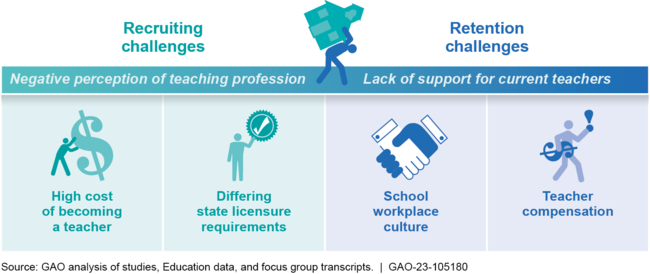K-12 Education: Education Should Assess Its Efforts to Address Teacher Shortages
Fast Facts
The U.S. is experiencing a shortage of teachers—a problem that worsened during the COVID-19 pandemic.
Teacher shortages are more prevalent in:
- western states
- rural and urban communities
- high-poverty communities
- certain subject areas, including foreign languages, physical science, and special education
The Department of Education introduced its vision in the summer of 2022 for "Supporting and Elevating the Teaching Profession." But, the department's strategy doesn't have important elements—such as timeframes or performance measures—that would help ensure its efforts are working.
Our recommendations address this.

Highlights
What GAO Found
Public K-12 teacher shortages occurred nationwide, but were more prevalent in specific geographic and demographic areas and specific subject matters, according to GAO's analysis of the most recent available national data. GAO found that shortages were most prevalent in the West, urban and rural areas (not suburban), schools predominantly serving non-White students, and subjects such as science and foreign languages. GAO also found that, as of school year 2017-18, the teacher workforce was mostly White (80 percent) and female (75 percent).
Negative perception of the teaching profession and perceived lack of support for current teachers are among key recruitment and retention challenges, according to GAO's literature review of research published from 2011-2021 (see figure). These same themes also surfaced repeatedly in all of 19 focus groups GAO held with current and former teachers, hiring officials, state officials, and officials from teacher preparation programs. GAO found that this perceived lack of support exists at the state, school district, and community level and increased during the COVID-19 pandemic.
Key Recruitment and Retention Challenges Contributing to Teacher Shortages

The Department of Education's plans for addressing teacher shortages do not have all of the elements GAO previously has determined as necessary for successful strategies. In summer 2022, Education announced an overarching vision for “Supporting and Elevating the Teaching Profession.” The vision includes five specific strategies and various activities to support teacher professional development and address recruiting and retention challenges. While Education has taken important steps to develop a comprehensive strategy to address teacher shortages, it has not yet clearly communicated time frames, milestones, or performance measures to gauge results of their efforts. Education officials said that the agency's priority to date has been on the initiatives associated with their vision. By building time frames and measures into its overall strategy, Education would be better positioned to know whether its efforts to help schools, states, and districts address teacher shortages are working.
Why GAO Did This Study
For years, parents and policymakers have raised concerns about teacher shortages. These concerns escalated during the COVID-19 pandemic, amid reports of teachers leaving the profession, fewer new teachers entering, and schools struggling to hire teachers.
The Explanatory Statement accompanying the Further Consolidated Appropriations Act, 2020 includes a provision for GAO to examine K-12 teacher shortages. This report examines (1) the prevalence of public K-12 teacher shortages and characteristics of the teacher workforce; (2) key recruitment and retention challenges contributing to shortages; and (3) the extent to which Education's efforts address these key challenges.
GAO analyzed nationally representative data for 2011-2021 (depending on dataset) to determine the prevalence and characteristics of shortages. GAO also conducted 19 non-generalizable focus groups, including with current and former teachers; hiring officials; and state officials. Further, GAO reviewed methodologically sound research and policy papers published in the last 12 years; relevant federal laws, regulations, and agency documents; and interviewed Education officials, researchers, and subject matter experts.
Recommendations
GAO is making two recommendations, including that Education develop a more comprehensive strategy to execute its vision. Education neither agreed nor disagreed with our recommendations.
Recommendations for Executive Action
| Agency Affected | Recommendation | Status |
|---|---|---|
| Department of Education | The Secretary of Education should build on the department's efforts to raise public awareness about the value of teachers by developing and including in its Elevating Teachers strategy time frames, milestones, and performance measures to gauge results. (Recommendation 1) |
Education neither agreed nor disagreed with this recommendation. In September 2024, Education officials stated they anticipated implementing this recommendation in December 2024 but they did not specify their actions. As of December 2025, Education was determining if this is still an administration priority. The agency stated that many of the resources allocated to help with this work are no longer available in ED.
|
| Department of Education | The Secretary of Education should direct Federal Student Aid and the Offices of Elementary and Secondary Education and Special Education and Rehabilitative Services to collect resources that address the key challenges contributing to teacher shortages, and share those resources with states and school districts in an easily accessible manner to help them address specific recruitment and retention challenges. (Recommendation 2) |
Education neither agreed nor disagreed with this recommendation. In September 2024, Education officials stated they anticipated implementing this recommendation in December 2024 but they did not provide information on their efforts to date. As of December 2025, Education was determining if this is still an administration priority. The agency stated that many of the resources allocated to help with this work are no longer available in ED.
|
